
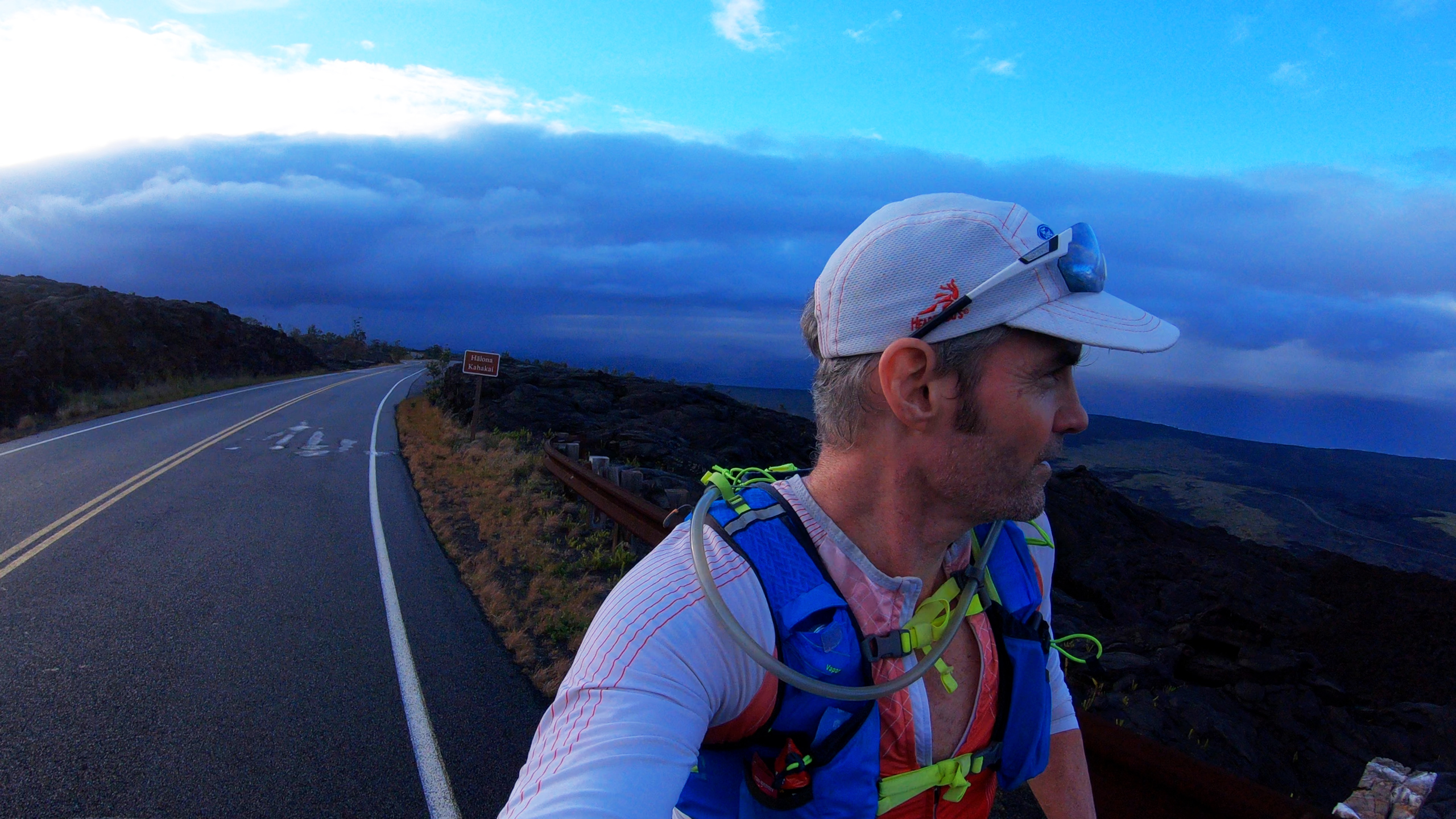
Let me start off by saying that Kīlauea presented quite a few more challenges than it seemed at first glance. First of all, how do you get a legitimate summit when the actual summit is not only off limits and illegal to get to, but also at some point it will likely fall into the summit caldera? As a climber, this posed a serious problem ethically for me. Secondly, there was no obvious ocean start where I can touch the water to start the whole run. Thirdly, since you are running on a popular road with no real shoulder and in an amazingly raw setting how do you ensure a fun run where you can really appreciate the setting you are in? And finally, the start of the run was nearly 3 hours from my house. So add a 6 hour round trip of driving to the run itself. Needless to say, it became a much bigger day than I initially expected.
It’s Saturday night and I have everything packed for a 34 mile run from a beach near the bottom of the Chain of Craters road (CoC) to the top of the Mauna Loa Strip Road. I plan to run to Kīlauea’s summit as well along the way as if it’s just the icing on the cake of this “training” run for Mauna Loa. I tuck the kids into bed and lay down for an hour but I can’t sleep. At 1 am I have the car loaded and ready to roll but… the starter of my 4-Runner has decided to finally give out on me. Karen comes down and convinces me I should take our only other vehicle – the minivan – and she would be ok without a vehicle for the day. Not ideal but I take the offer. Forty-five minutes into the drive I’m crossing the saddle feeling the presence of the two enormous volcanoes I’ve been training for looming largely on both sides of me. As I enter upper Hilo, as if on cue, it begins to rain and continues to rain until I reach Mountain View where it changes into a light mist. Entering the Volcanoes National Park I head to the Kīlauea Military Camp (KMC) where I stash my cooler at the 21-mile mark in the run. Finally, at 4am, I park the van at the Puna Coast Trail Entrance near the bottom of the Chain of Craters road. On Thursday I had come to Volcano to get a few questions answered (an account of that trip here) and this was where the whole adventure would need to begin. I grab my running pack, leave the bladder (with 6lbs of water in it), press the start button of my Garmin watch, and unceremoniously head away from the road deeper into the darkness.
I pick my way much slower than expected along the pahoehoe flows looking for the next ahu (cairns – a stack of rocks). Around 3/4 of a mile into the “trail” I check my GPS app Gaia and see I now need to head off trail directly towards the coast. The going is even slower now since jogging on these flows by headlamp demands you stare down directly in front of you. If you want to check if your overall bearing feels correct you need to slow down and/or stop before you lift your head or risk taking a bad spill. At 1.4 miles in I’ve picked my way to the exact location I need to get to the ocean. Cliffs line the water’s edge for miles in both directions – except for this little oasis. I reach down into the water with a small container and collect my offering for Halema’uma’u. Turning around, I look up into the darkness towards the mountain, take a deep breath of thick ocean air, and start my journey upwards.
Back at the van, I notice almost an hour has passed since I began this run. I’m a little stressed by that fact and once my water is loaded and the van is locked, I am rushing off up the road. Within a few minutes, I’ve convinced myself to slow down since this is going to be a long day and I’ll make up the time over the next 31 miles. By 5:40 am the sky has lit up enough that I can turn off my headlamp. As I turn into the first switchback I start to see how absolutely audacious the construction of this road was. Raw black flows are sheared into 20-foot plus cliffs along the mauka side (toward the mountain) of the road. The enormous effort required to cut this road out of what is, in essence, a lava cliff is impressive. The grade of the road is not easy but not at all “steep” by the standards of many roads on the Big Island. I plug along at over a 13 minute/mile pace saving up energy for later in the day. By the time I finish what I would call the end of the switchbacks I’m 9 miles into the run and have gained 1800 feet. The switchbacks made up 4.25 miles and 1,300 feet of that which really wasn’t too bad at all. At this point I’m 2:15 into the run and still have not seen one car or sign of human life – and that is awesome!
Over the next hour, I travel through old and new lava flows, passing one island of forest that evidently was completely missed by fresh flows on both sides of it. I enter a new forest and soon reach the right-hand turn I’ve been waiting for. Only 2 cars have now come by in 3 hours and 40 minutes. I’m tempted to keep testing my luck on this main road yet I’ve been looking forward to seeing this dirt path known as the Escape Road and guarantee to be deep in nature for the next 4 miles. But one thing I did not factor in was how wet I was going to get on this path. Over the previous hours, there was a fine mist or soft rain floating in the air and the cumulative effect on my shoes and clothes has been minimal. But now long grass grows all over the Escape Road with each strand holding dew and water from the mist. My shoes and socks are soaked within minutes. As my feet squish their way up this road I realize that without a change of shoes at my transition area I’m going to have wet shoes for the next 4 hours and 18 miles. This still is an excellent route though and I am deep in the rain forest bursting with ferns and ohia, loaded with the sound of birds busy with there day, and the evidence of wild pigs tearing up chunks of the road in search of tasty roots. And I am truly enjoying this section regardless of wet feet for the rest of the day.
It’s around this time I take stock again of my overall wellbeing for the day. This is a common practice you want to consistently do on long endurance days. Ultimately you ask yourself: How does your energy feel? Have you been sticking to the heart rate/perceived effort plan? Have you been fueling and hydrating properly? How do the muscles feel and are there any niggling issues in the joints or muscles? And if any of these questions raise a concern you address it by telling yourself what you need to do to correct that concern. Otherwise, check the boxes and keep moving on until the next assessment. So at this point, I actually feel great. I’m a bit tired but honestly, you are going to be a bit tired 4 hours into an uphill run. My mind passes over the training I’ve done in the last 3 weeks since my first trip up to Mauna Loa’s summit and I feel that my overall energy has been lower and I was sick a few days. I had placed this 34 mile, 7000 foot gain workout on my training plan 2 months earlier (yep, I’m that anal – haa) understanding what was most important about this run was the psychological factor in knowing the fitness was there to cover 60% of the run in one push. For endurance athletes, we recognize our brain is our greatest asset and worst liability. The more training you show your brain you have done the more likely it can come up with rationale as to why you should continue even when it feels that the proverbial wheels are coming off the cart. But the opposite is also true: miss or don’t complete a few key workouts and your brain will tell you late in the event that of course everything is hurting and you are having a bad day – you didn’t do all the work and you’ll probably fail. So typically there is no way I would let myself fail to complete this workout. Luckily before I started the run I knew that best case scenario I would finish the 34 miles. And worst case was “Merely” doing the Sea to Summit of Kīlauea. And to be honest, the more I ran up this volcano the more respect I had for how amazing and unique it was from the other 4 volcanoes on the island. On paper, it appears as though Kīlauea is some group of erupting craters on the side of Mauna Loa. But as you run the whole southern flank of this volcano you keep looking up at the horizon and see the long eastern slope of Mauna Loa appearing miles away. You honestly understand you are not on Mauna Loa – you are “ON” Kīlauea. And at that moment 3 mile or so into the Escape Road, I release myself from the obligation to run all 34 miles and allow myself to embrace this run as solely the Sea to Summit of Kīlauea. And in doing so I ensure this adventure will not be a footnote on a training run for Mauna Loa. Wow, does my energy perk up and I realize I can actually pick up the pace since there are only 6 or so miles left to go.
Over the next 80 minutes, my heart-rate raises to a 158bpm (beats per minute) average up from 143bpm for the previous 4 hours. My enthusiasm is high as I come back out onto the main road at the Thurston Lava Tube parking area. It’s around 8:45 am and I finally see signs of human life. A few cars pass in each direction as I head for the entrance to the park. I would have loved to run around the crater rim trail but many sections have been closed so I just turn onto Crater Rim Drive. Now there is traffic and signs of human life everywhere. I run through this little zoo of people and turn off the road at the steam vents. I come up to the railing overlooking the Kīlauea Summit Caldera and Halema’uma’u herself. A young couple happens to be coming by at the same moment, and oddly I feel rushed, so I hand them my GoPro and they film me making a bone-headed move – I step through the railing and lean over the caldera and give my offering and a few thoughts and words to the Volcano. I feel good about the offering yet basically, the video is a “What not to do” when at the summit rim of Kīlauea. I think I feel rushed because I don’t feel this should be the finish of the run. This point is 80 feet lower and 1.6 miles away from the true summit. In hindsight, I would have taken a few more minutes, captured a few more photos, and embraced how appreciative I was to be healthy and fit enough to have run from the Sea to the Summit Caldera. Instead, I rush off to the other possible new summit I had established the day before. I head to the KMC and pass my water stash since I won’t really need it. I head down the Mamalahoa Hwy and turn onto the Mauna Loa Strip Road. A block up the road there is a street that is on a 4040-foot contour rise and still theoretically Kīlauea. I run down this road a few feet and then press the stop button on my Garmin watch. The run is officially over. This spot seems strangely arbitrary to stop the run. But having done the math the previous day I knew that if I “only” ran the Sea to Summit of Kīlauea I needed to run 1.6 miles more from the railing at the steam vent. This was approximately how much further I would have had to run along the Crater Rim Trail to the actual summit had the area been open to run. So not only was it one of the highest points I could get to legally on Kīlauea, I covered the distance needed to have officially touched the highest point. A minor consolation prize but it will have to do.
Overall I really enjoyed this adventure and I’m glad it was exclusively the run of Kīlauea. There is an amazingly raw energy you feel while moving by foot along this volcano. It really exposed human insignificance (and all life in general) in the face of the sheer force of its flows. Every bit of life on this volcano feels transient. It’s like we are little ants erecting an insignificant path only to get washed away by the next rain – that will come. For me, the early morning start was key to having the Chain of Craters road to myself. My guess is, if I were to do it again, I would hike slowly out to the ocean in the dark and wait for enough light from sunrise to start the run without a headlamp. I would also not have worn a 12-pound pack and just had a couple water bottles hidden along the road. I was a little over-prepared for this run – haaa. I’m going to highly recommend this adventure to anyone interested in running one of our volcanoes for the first time. It’s the perfect adventure if you are staying a couple nights in Volcano. Start early, do the ocean start (it has a fun raw feel), make an offering to the Summit Caldera, and jog your way back to the place you are staying (you’ll get in your extra 1.6 miles – haaa).
Relive ‘Kīlauea Sea to Summit’
Of course, when the run was over my friend Annabelle picked me up and drove me the 45 minutes back down to the minivan. I headed over to her place to chat and eat for an hour then readied myself for the long drive back home. Once my AT&T connection finally came back in Mountain View I called my biggest fan and spent the next hour sharing my latest adventure with her while it was still fresh and raw in my head. And you know Moms – they love to hear your latest stories, no matter how silly they are.
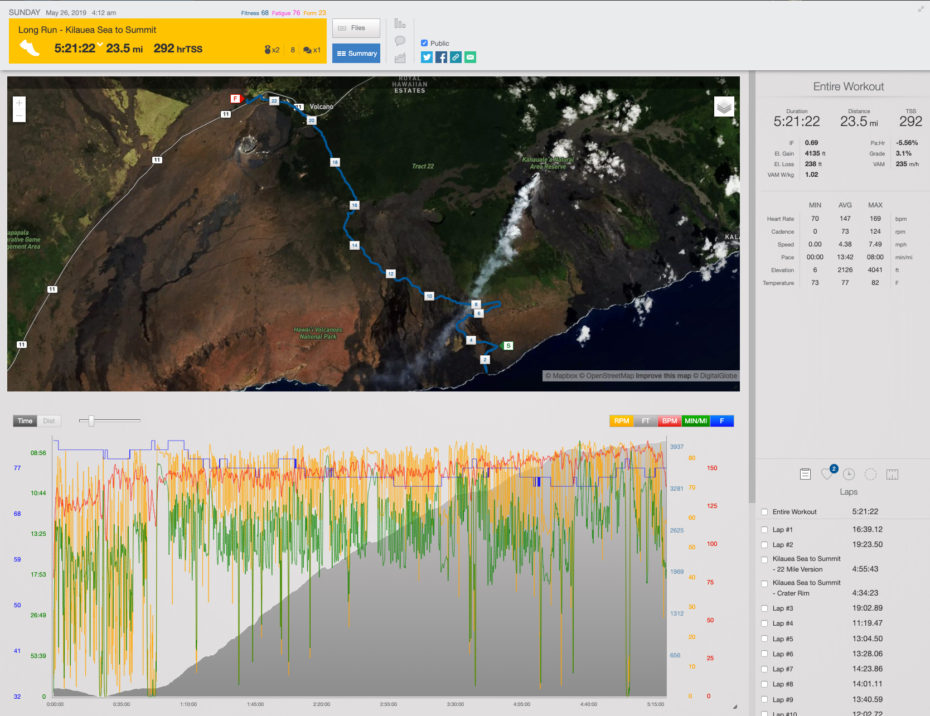

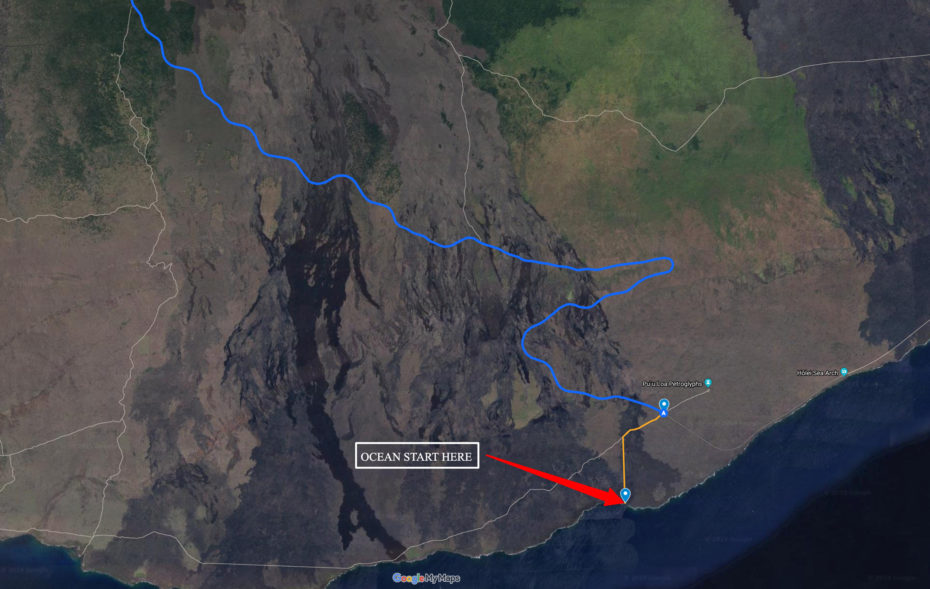
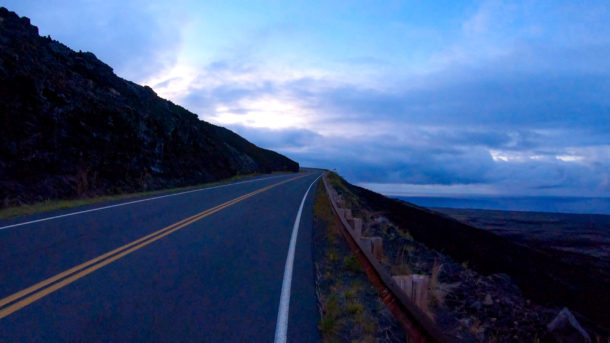
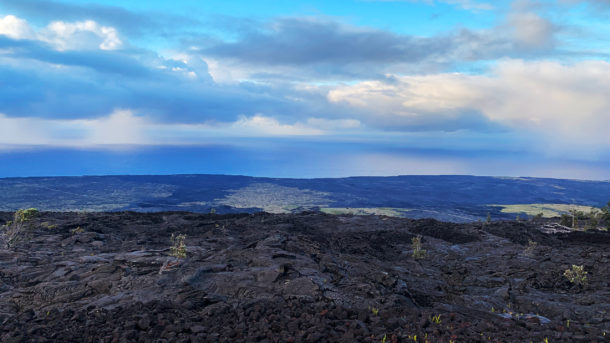
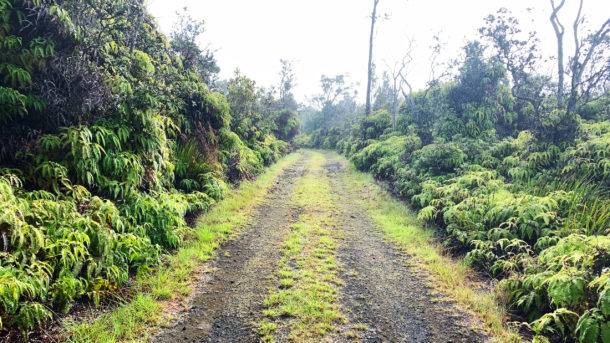
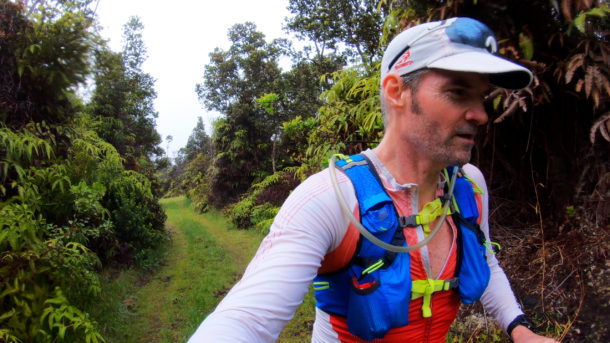
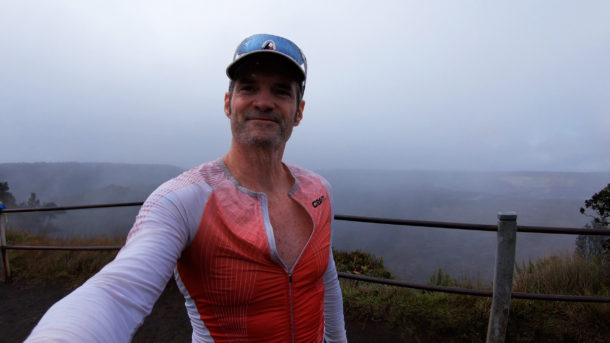
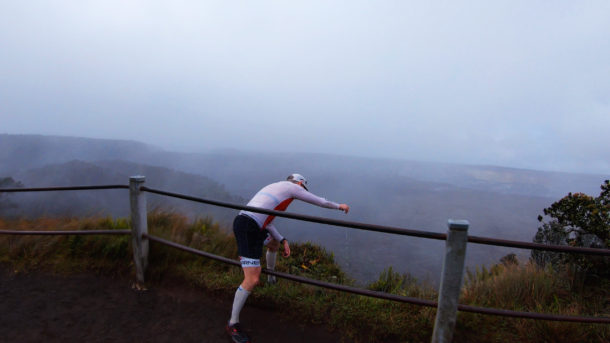
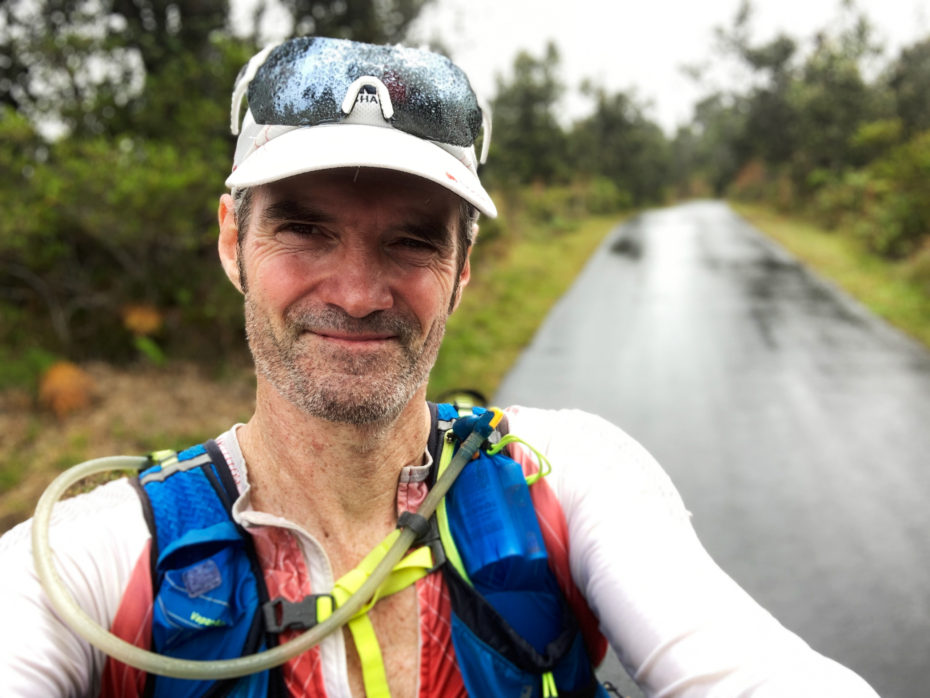


Leave a reply